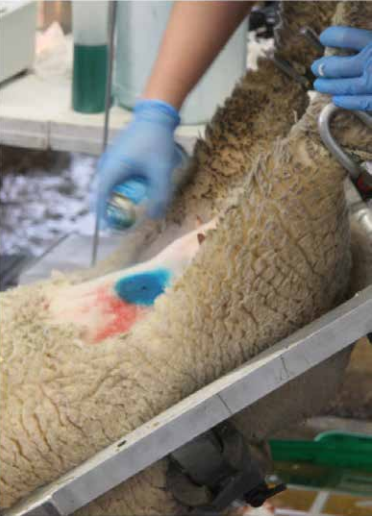Prepping the ewe in the cradle
When I was a teenager which is now 50 years ago, my parents had a rather chaotic go at “The Good Life” on 20 acres in West Kent. Our first enterprise were some Jacob sheep (much smaller, more traditional and primitive than today’s giant Jacobs), the next was rearing “bobby” calves, then chickens - Rhode Island Reds with a Maran cockerel, and our fourth was a house cow.
The first house cow was a lovely pedigree Guernsey called “Eastwell’s Cutie’s Cherub”. She was about 10 years old when we bought her at the Eastwell herd dispersal, she was milking but empty. Sadly, although we caught her bulling several times, she never held to AI service... so that was my first experience of AI. A man in a brown stockman’s coat undertaking the very simple procedure of inseminating dairy cows with good quality semen, to a peacefully tethered cow. Sadly, Cherub dried up and was replaced by a rather too pretty Jersey called Clover. (My father loved gold top milk). If only AI in sheep was so easy and cheap.
Every now and then I like to find a new way of losing money with my sheep usually by trying something new. So 2023/24, was my first attempt at sheep AI. It is nothing like as simple as cattle. What a surprise!
Everything neatly laid out ready for action
The first headache was to find a vet/ vet technician who knew what they were doing, not easy in the East and my practice did not have anyone in their local team but there was an expert colleague in a sister practice in Hampshire - 100 miles away. So, a provisional plan was made the preceding winter and various medicines booked - given that these days some meds seem to be erratic in their availability - with the objective of AI-ing c. twenty ewes the autumn, just before the tups went in with my main group of ewes.
The schedule was this: ewes for AI were to be sponged with progesterone (eg Chronogest) with the sponge removed after 12 days, as the sponges were removed they were then treated with pregnant mare’s serum gonadotropin (PMSG) and prostaglandin (Eg Estrumate). This process was split into morning and afternoon batches so that the AI would take place exactly 48 hours after sponge removal. The night before AI was due to take place all feed was removed - as it is easier for the vet to perform the AI with an empty stomach.
On the day, each ewe was given a sedative as well as pain relief and a precautionary antibiotic. The ewes were then secured on their back in a padded cradle. The vet made two small (5mm) “trocar” incisions into the abdomen, one to allow insertion of the semen directly into the uterus, and the other to enable visualisation via a laparoscope. After the semen had been successfully placed the ewe was released and returned to the group. Although not necessary the ewes were kept in for 48 hours. During the process, the vet examined the semen - three different rams were being used. I was not aware of this, but semen can these days be stored as straws or as frozen pellets. On examination the vet decided the semen from one of the rams with frozen pellets was not of a particularly good quality/ density so he advised that we should double up the dose. This meant unfortunately there was not enough pellets for some of the ewes prepared for AI which was bit frustrating. The semen from the other two rams was fine. The vet explained that in his opinion while frozen pellets can be fine, the process of prepping and freezing the pellets was a bit hit and miss and could result in an inconsistent number of sperm (volume and density) and potentially greater damage to the sperm during the freezing process (edge effects) compared with straws.
Laparoscopic equipment in place
Lining up to ensure correct placement of semen
The whole process is not cheap. For a “group of 25” the total cost per ewe was c. £50 head, with medicines accounting for 1/3 of these costs. In addition, there was the cost of ram semen: £5-25/ head and specialist despatch £100 per storage centre, the latter was an unexpected/ unplanned fee. So roughly you are looking at an all in cost of £80-100/ewe.
No stitches needed, just blue antibiotic spray
So how did it all work out. Of the 27 ewes prepped for service 21 were AI’d, one had lost her sponge and five missed out due to the need to double up on semen for one ram. At tupping of the 22 AI’d eight had returned to service, one of the rams 9 out of 12 held, another 4 out of 5 held and one - ironically, the ram with the most expensive semen only one out of 6 held. Unfortunately, sheep being sheep, two of the AI’d ewes died due to causes unrelated to AI. Looking at the ewes that failed to hold it would be fair to say they were not in as good condition as I would have liked, their Condition Score was nearer 2 than 3. It was noticeable that fatter ewes 3s and 4s did seem to hold better though the vet found it harder to AI those with a CS of 4. So come lambing all the lambs that were by an AI tup survived that was a bit of a relief, those ewes who did not hold to AI did hold to natural service on their next cycle, another relief.
Some lessons for others
Plan well ahead ideally a year or more to get clarity on your target AI and then lambing dates
Find a vet/ technician with the skills, competence and availability.
Book the AI date
Order/pre-book medicines early
Check if any other local breeders want to join up – it reduces overall costs
Talk to and follow the vet’s advice
Take out a mortgage!
8. Get ewes in good condition CS 3-3.5
9. If given the choice take and buy semen as straws.
10. Get an extra pair or two pairs of hands to help on the day
11. When requesting semen have some cheap/ spare semen to hand in case not all of the preferred semen is up to scratch. 12. On the day do as you are told by the vet!
Patrick Goldsworthy MBE, Webb Ellis and Heritage Flocks
With thanks to Matthew Dolbear MRCVS BVetMed BSc(Hons) Westpoint Vets (Winchester)







